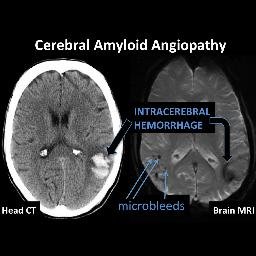Going after a related disease that adds to dementia and brain bleeds
 A $3.3 million grant from the National Institutes of
Health will support a University of Rhode Island neuroscientist’s research to
identify early-stage biomarkers for a brain disease often found to coexist with
Alzheimer’s disease.
A $3.3 million grant from the National Institutes of
Health will support a University of Rhode Island neuroscientist’s research to
identify early-stage biomarkers for a brain disease often found to coexist with
Alzheimer’s disease.
The
five-year grant was awarded to William Van Nostrand, Hermann Professor of
Neuroscience at URI’s George & Anne Ryan Institute for Neuroscience.
The funding will help fill a critical research niche in early detection of cerebral amyloid angiopathy, a disease in which amyloid deposits form in small and medium blood vessels in the central nervous system, contributing to dementia and brain hemorrhages.
Although the disease is common in the elderly, it often isn’t diagnosed until its late stages, when bleeds can be detected by brain imaging.
The funding will help fill a critical research niche in early detection of cerebral amyloid angiopathy, a disease in which amyloid deposits form in small and medium blood vessels in the central nervous system, contributing to dementia and brain hemorrhages.
Although the disease is common in the elderly, it often isn’t diagnosed until its late stages, when bleeds can be detected by brain imaging.
“Early and accurate diagnosis of this condition has remained elusive,” said Van Nostrand. “There is a need for biomarkers for early stages of disease prior to the presence of lesions detected by neuroimaging. The purpose of this project is to fill this void by developing and validating robust biological fluid markers for CAA.”
The
project, which begins in July, will be conducted in collaboration with
Professor Marcel Verbeek at Radboud University Medical Center in Nijmegen,
Netherlands, based on previous work by the Verbeek and Van Nostrand
labs that identified potential cerebral amyloid angiopathy biomarkers in
brain tissue.
A biological fluid marker not only could potentially provide an earlier, more accurate diagnosis of the disease, but could also help guide treatment options, particularly in therapies where the disease represents a heightened risk of hemorrhage.
A biological fluid marker not only could potentially provide an earlier, more accurate diagnosis of the disease, but could also help guide treatment options, particularly in therapies where the disease represents a heightened risk of hemorrhage.
Van
Nostrand arrived at the Ryan Institute in the fall of 2017 from Stony Brook,
bringing with him $4.1 million in grant funding. He is noted for being the
first researcher to purify and characterize amyloid precursor protein, the
progenitor of the amyloid-beta protein that forms hallmark plaques in
Alzheimer’s disease.
“Our goal is ultimately to identify mechanisms of disease that could be targets for new treatments,” he said.
“Our goal is ultimately to identify mechanisms of disease that could be targets for new treatments,” he said.
Founded
in 2013, the Ryan Institute for Neuroscience is focused on investigating factors
in neurodegenerative disease that have been under-explored, including
inflammation, the immune system, and the role of blood vessels in the
development and progression of disease.